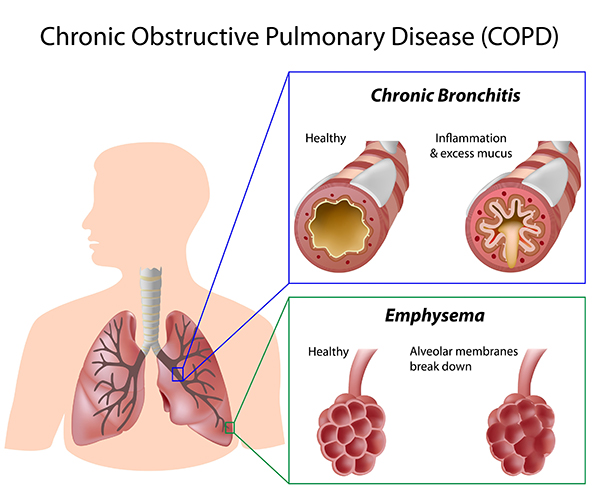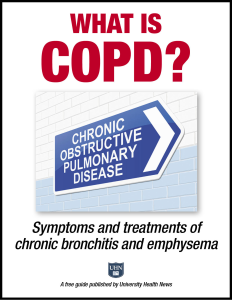Lung Diseases and COPD Facts: Understanding the Breathing Process
Do you know how many breaths you take every day? The answer is, for most people, 12 to 20 breaths every minute. If you’re suffering from COPD, facts show that it can be a struggle. To help you understand the breathing process, let’s start with your lungs.
The lungs consist of two large, spongy organs divided into sections called lobes. The right lung has three lobes, the left has two. Inside the lungs is a branching system of progressively smaller tubes (called bronchial tubes), at the end of which are air sacs. Oxygen and carbon dioxide travel through these tubes.
Once air is breathed in through the mouth and nose, it passes through the voice box (larynx) and enters the windpipe (trachea), the opening of which is at the back of the throat in front of the top of the esophagus (through which food is swallowed). Air then travels down the trachea into the bronchial tubes in the lungs.
The system of bronchial tubes looks like the branches of an inverted tree. The main trunk is the trachea, and it branches into two large tubes called the right and left mainstem bronchi, each leading into one of the two lungs. These bronchi branch off into smaller and smaller tubes.
As the tubes get smaller, they are called bronchioles. The trachea and the bronchial tubes (bronchi and bronchioles) are often referred to as “airways,” and it’s these that are affected by COPD signs and symptoms.
Get Your Breath Back!
Download this expert FREE guide, What Is COPD?: Symptoms and treatments of bronchitis and emphysema.
Get this FREE Guide filled with clear answers to your most important questions and concerns about lung health.
Oxygen In and Carbon Dioxide Out
At the end of the bronchioles are clusters of tiny air sacs that look like bunches of grapes. These are called alveoli, and the lungs contain millions of them. When you inhale, these sacs expand as they fill with air. When you breathe out, the air sacs deflate as air moves out of the lungs.
The alveoli have very thin walls and are surrounded by capillaries (the smallest blood vessels). Where the alveoli and capillaries meet, gas exchange takes place. Oxygen moves across the walls of the alveoli and enters the tiny capillaries, where it is absorbed into red blood cells.
This “oxygenated” blood begins its journey to the heart and then the rest of the body. At the same time, carbon dioxide from the blood in the capillaries passes into the alveoli. From there, it is expelled from the body through exhalation. This exchange of gasses—oxygen in, carbon dioxide out—takes just fractions of a second.

Chronic obstructive pulmonary disorder is actually two conditions: chronic bronchitis and emphysema. Inflammation of the airway causes overproduction of mucous the constant cough associated with bronchitis. Emphysema compromises the alveolae at the end of the bronchial tubes, leading to loss of oxygenation of the blood and resulting fatigue.
COPD Facts and Figures: The Breathing Process
As noted above, most people take 12 to 20 breaths every minute of every day. This occurs automatically, with no effort required, but you can also consciously control your breathing, making it faster or slower and even holding your breath for a brief period of time.
The automatic function of breathing is controlled by the brain stem (the lower part of the brain that connects to the spinal cord). Functions located in the brain stem include those that are necessary for our basic survival, including breathing, digestion, heart rate, and blood pressure.
When the brain senses that there is too little oxygen or too much carbon dioxide, it sends signals to increase the speed and depth of breathing. Because cells (including muscle cells) require oxygen for energy, breathing increases with exercise and slows down during rest.
The mechanical process of breathing depends on several muscles, the largest of which is the diaphragm. This dome-shaped muscle separates the chest cavity from the abdomen, and is positioned just below the lungs. During inhalation, the diaphragm flattens out, causing the chest cavity to enlarge. This reduces pressure in the chest cavity, and allows air to be drawn into the lungs. When the diaphragm relaxes, air is pushed out of the lungs.
Other muscles also are at work during the process of breathing. When these muscles are working most efficiently, more air is pulled into lower lobes of the lung.
Role of the Heart and Circulatory system
There are two types of blood vessels: Veins carry blood toward the heart, and arteries carry it away from the heart. Arteries bring blood that contains oxygen (oxygenated) to the tissues of the body and veins carry blood that is void of oxygen (deoxygenated) and contains carbon dioxide back to the heart.
Through the heart’s pumping action, blood that has been depleted of oxygen and contains carbon dioxide is sent from the heart into the lungs. Once gas exchange takes place in the lungs, the newly oxygenated blood returns to the heart. From there, the heart pumps the oxygenated blood into the aorta (the main artery), and out into the branching system of smaller and smaller arteries to reach the rest of the body.
Protective Mechanisms of Bronchial Tubes
Bronchi and bronchioles are essentially tubes with muscular walls. Lining the inside of these tubes are several layers of tissue. The innermost lining is called the mucosa, and it contains cells that help to protect the lungs. One type of cell in the mucosa produces the sticky substance known as mucus. The mucosa also contains cells with hair-like projections called cilia.
Mucus serves many useful functions. For example, it traps bacteria, pollen, and other particles that have been inhaled. These are then swept away from the lungs and up toward the mouth by the motion of the tiny cilia, and cleared away, mostly through swallowing. Coughing can also get rid of mucus. When you get a cold or flu, excess mucus is created. The mucus (also called sputum) that comes up when you cough is helping to eliminate the infectious agent. Once the infection is gone, mucus production returns to its normal state and coughing eventually stops.
The bronchial tubes are surrounded by bands of muscle. Certain cells in the lining of the bronchial tubes have receptors that stimulate these muscles to contract and relax. For example, a type of receptor called a beta-adrenergic receptor causes muscles to relax, which widens the airway, making it easier to breathe.
Another type of receptor, called a cholinergic receptor, causes the muscles to contract, which narrows the airway and makes it harder to breathe. Normally, the purpose of narrowing the airways is to keep irritants out of the lungs. For people with COPD signs and symptoms, this narrowing can make it even more difficult to breathe.
For further reading on the COPD issues and treatment, see the following University Health News posts:
- “What Does COPD Stand For?“
- “What Is COPD? Chronic Obstructive Pulmonary Disease“
- “COPD Stages: How Chronic Obstructive Pulmonary Disease Advances“
- “Extra Help for COPD Signs and Symptoms“
Originally published in June 2016 and updated.
The post Lung Diseases and COPD Facts: Understanding the Breathing Process appeared first on University Health News.
Read Original Article: Lung Diseases and COPD Facts: Understanding the Breathing Process »
Powered by WPeMatico


